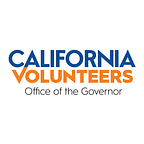California Demonstrates the Potential for a National Climate Corps
by Josh Fryday, California Chief Service Officer
California fires, drought and heat waves have been the face of climate change. Now, we are working to be the face of people-powered climate action. We are working to change the culture around climate action, and we are thrilled to see support growing nationwide from the Biden Administration and Congress for a National Civilian Climate Corps.
We hope the lessons learned from the California Climate Action Corps (CCAC), launched by Governor Newsom and California Volunteers last year during Climate Week, can be helpful as a viable and active model as Congress and the President work to scale a Climate Corps nationwide.
The CCAC has taken aggressive action to tackle climate change with the strength of Californians willing to engage on a local level. Like the proposal for a National Climate Corps, the CCAC puts young people to work as AmeriCorps members and trains them for environmentally friendly careers, putting them to work by planting trees, reducing food waste, and promoting fire mitigation efforts. The CCAC also seeks to empower all Californians, so whether you have a year to give, or an hour to give, there is something for you to do.
In our pilot year, hundreds of California Climate Action Corps members have served across the state in frontline communities most affected by climate change, and our program is already making an impact.
A few lessons to share:
I. Inclusivity
The first key to success is building Climate Corps to be inclusive. Service programs have enormous potential to unite our communities, bringing people of all backgrounds together to create common experiences around work towards a common purpose. Unfortunately, not everyone has always been able to serve. The original New Deal Civilian Conservation Corps (CCC) — etched into our collective imagination for putting millions to work planting trees and building parks — often excluded and discriminated against minorities and women. Currently, AmeriCorps, the largest domestic service program, excludes Dreamers and non-citizens from serving.
In California, we have worked to be more inclusive from targeting projects in frontline communities most in need, to recruiting members so our teams better reflect our communities. To further strengthen our inclusivity efforts, this coming year we are launching the #CaliforniansForAll College program with a climate area focus and will include eligible AB 540 Dreamers. We must continue to work hard and intentionally to ensure the program is more inclusive. Our California Corps should represent all Californians and the National Civilian Climate Corps should represent America.
Inclusivity also means fairer pay. We simply need to pay AmeriCorps members and our service members more.
Service for the sake of service is a wonderful concept, but it ignores a universal reality — we need to make enough to live. To achieve the vision of working toward a common purpose, service opportunities cannot be left to the wealthy or privileged. When I served as an Officer in the U.S. Navy, I was paid because, after all, it was my job. Pay should reflect the incredible value brought by Climate Corps members to protect our communities. The average AmeriCorps member in California currently makes a stipend over 10 months of roughly $18,000. For future CCAC members, we are aiming to increase the stipend to $27,000, with a $10,000 scholarship to help pay for college or student debt. This is just the beginning, and we recognize we need to continue doing more.
II. Support Local Goals
Climate activities must identify and work to meet local goals. Our success comes from finding local partners and listening to their needs and climate action goals. A statewide or national project is only as good as its local efforts and partnerships. For example, our Corps Members are working with the City of Los Angeles to assist on more than a dozen of their climate action plan goals, making a direct impact where the community feels they need it most.
III. Engage Everyone
By working to mobilize and empower ALL Californians to be a part of the solution, we must create a universal culture of climate action and awareness. With the issue this big we need to engage the entire community, and too often people ask us, “What can I do?” It’s time to finally answer this question for everyone.
Through engaging the whole community, we can create a culture encouraging all of us to make impactful changes at home and at work. We hope this also creates a culture empowering us all to seek broader institutional action on climate change — forcing systems to change.
In Fresno, our Corps members engaged the broader community by collaborating with the Fresno Metro Black Chamber of Commerce and volunteer group TreeFresno to mobilize nearly 1,000 volunteers to plant more than 400 trees.
We hope our experiences and learnings in California can help the launch of a nationwide Civilian Climate Corps. For the future of California, our nation and the planet, we are rooting for its success.
Join us at ClimateActionCorps.ca.gov
